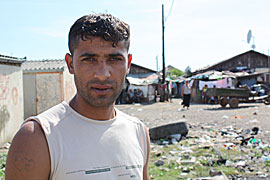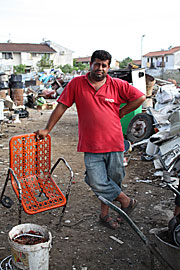Montenegro’s Roma camp shame
Unable to work and scared to go outside; life inside Europe’s biggest refugee camp.

 |
| More than 2,000 Roma refugees live in Konik camp just minutes outside the capital of Montenegro |
In a series of special reports, Al Jazeera examines the plight of refugees across the globe to mark Refugee Day on Saturday, June 20.
Elvis has never been to school and he doesn’t think he would like to.
| Refugee special |
|
|
He will be seven in August and has lived his entire life in the Konik camp for Roma refugees, a sprawl of tents and makeshift wooden huts on the outskirts of Podgorica, Montenegro’s capital, next to the country’s largest rubbish dump.
His family has lived here since they fled the fighting in Kosovo ten years ago, leaving their homes and all their belongings behind as they ran for their lives.
Three weeks ago the wooden hut they had lived in for the past ten years burnt to the ground along with 18 others – leaving 124 people homeless.
Fires are frequent in camp because of bad wiring and the use of open stoves and candles.
The family of 13 now lives in a tent provided by UNHCR, the United Nations refugee agency.
The Red Cross has given them some flour and oil, but they don’t have enough food or water. Survival, rather than Elvis’s education, is their current priority.
Food scraps
Elvis doesn’t mind his new home as long as he and his best friend, also called Elvis, get to play with their little toy cars.
His family, who have now lost everything they own for a second time, are frustrated and scared.
 |
| Elvis’ family of 13 live in one tent provided by the UN |
His 59-year-old grandmother asked not to be named, afraid the local Montenegrin community would target her family if she spoke out about their conditions.
So anonymously, she explains: “The conditions we are living in are inhuman.
“We could almost accept this life when it was wartime.
“It’s been ten years [now] and we still live like this, now the government needs to help us.”
Elvis’s uncle, 31, adds: “My mother and wife beg in town. My brother and father pick food from garbage cans.
“I have no idea how long we will be living in this tent for. Why is no one helping us?”
Konik is the largest refugee camp in the Balkans. It is home to more than 2,000 Roma refugees, most of who fled the conflict in Kosovo over a decade ago.
Of the 1,300 students at the local primary school, 270 are Roma.
Save the Children has been working in this school since 2002, hoping to integrate students from the camps into the community through inclusive education projects. It is an uphill struggle.
The mayor of Podgorica recently called for Roma refugees to return to where they came from.
The primary school principal complains that Roma children have poor attendance and a high drop out rate.
Several parents from the local community have withdrawn their children from classes with high numbers of Roma kids and enrolled them in other schools.
Putrid smell
After ten years, the wider community does not acknowledge the refugee Roma’s right to remain.
Refugees are unable to work in Montenegro because they don’t have the correct documentation and many of the children don’t go to school because of poverty and fear of bullying.
 |
| Takovo says the refugees can’t go outside the camp as locals pick fights with the Roma |
Few feel comfortable leaving the confines of the over-crowded camps so days are spent inside the wire-fenced parameter searching for shade and listening to the Kosovan folk songs booming from stereos.
In summer, temperatures regularly top 40 degrees celsius and the stench from the piles of rubbish the children play in is putrid.
The camp has a supply of electricity and water but not enough to go round. For Takovi Aziz, 24, life in Konik is unbearable.
“We are young, we are strong but we can’t work. I have no right to work here because I am Roma and because I am from Kosovo.
“The conditions are getting worse and worse. I can’t stand it anymore,” he says.
“We can’t go outside of the camp because the locals here pick fights with us, so we’re trapped.
“The whole of Montenegro must despise us, why else would they let us live like this?”
Health risks
Most people in Konik make whatever money they can from collecting scrap metal from the nearby rubbish dump and selling it on for money.
Skender, 30, earns $280 a month doing this, but it’s not enough. “My children are hungry and I can’t give them any food,” he says.
 |
| ‘We just sit here without a purpose,’ says Skender |
Skender explains that when it rains, the wood and tin hut where he and his family live floods.
The damp means his five children are often sick with colds and have problems with their lungs.
He thinks it is getting even harder for the refugee community here to survive.
For seven years, he explains, a local cleaning company employed around 70 people from the camp.
They were all recently fired for not having the correct paperwork and promptly replaced by Montenegrins.
Skender asks: “We want to live better lives but how can we? We have no support from the government, we have no support from the USA or the United Nations so we just sit here without a purpose in this camp.”
Watching his children play in the ashes of the burned out buildings, he adds: “Our children have nothing and we don’t have a choice.”
Phoebe Greenwood works for Save the Children charity, a UK-based charity.
For more information on Konik camp please visit www.savethechildren.org.uk
The views expressed in this article are the author’s own and do not necessarily reflect Al Jazeera editorial policy.

